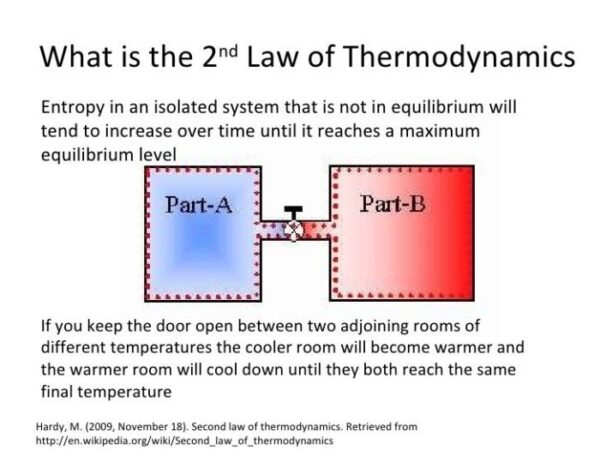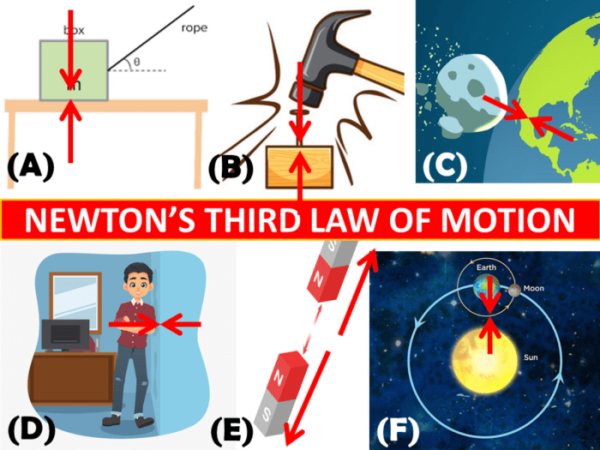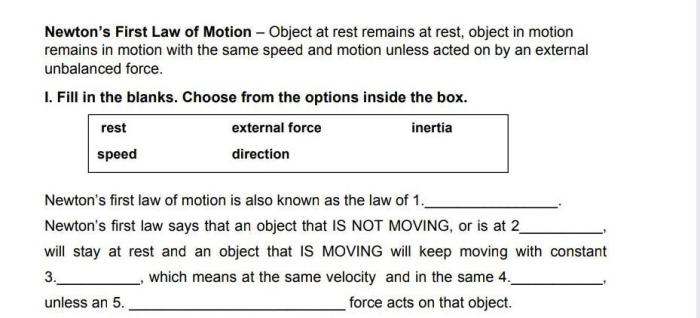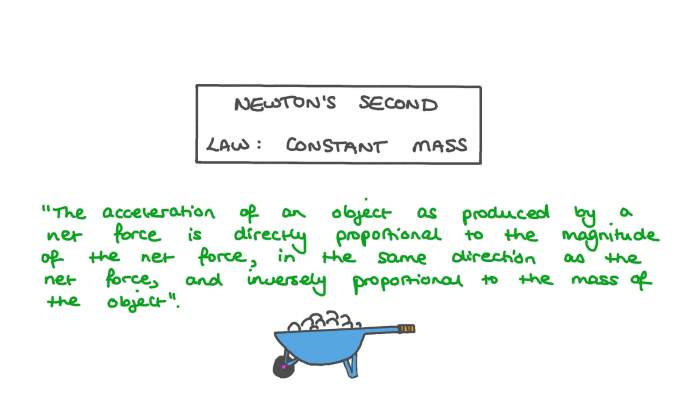
What is Newton’s 3rd Law of Motion? It’s a fundamental principle in physics that governs how objects interact with each other. This law, often referred to as the “law of action and reaction,” states that for every action, there is an equal and opposite reaction. It’s a simple concept, but it has profound implications for understanding how things move in the universe.
Imagine a rocket launching into space. The rocket expels hot gases downwards, creating a force that propels it upwards. This is a classic example of Newton’s Third Law. The rocket’s action is the expulsion of gases, and the reaction is the upward thrust that lifts the rocket off the ground. This law applies to everything from the movement of planets to the way we walk, making it a cornerstone of physics.
Introduction to Newton’s Laws of Motion
Newton’s Laws of Motion are fundamental principles in physics that describe the motion of objects. These laws provide a framework for understanding how objects move and interact with each other. They are essential for understanding a wide range of phenomena, from the motion of planets to the design of machines.
Newton’s First and Second Laws of Motion
Newton’s first two laws of motion are essential for understanding the basic principles of motion.
- Newton’s First Law of Motion (Law of Inertia): An object at rest stays at rest, and an object in motion stays in motion with the same speed and in the same direction unless acted upon by an unbalanced force. This law states that objects have a natural tendency to resist changes in their state of motion. For example, a book on a table will remain at rest unless someone pushes it. Similarly, a car moving at a constant speed will continue moving at that speed unless brakes are applied or an external force acts on it.
- Newton’s Second Law of Motion: The acceleration of an object is directly proportional to the net force acting on it and inversely proportional to its mass. This law describes the relationship between force, mass, and acceleration. It can be represented by the formula:
F = ma
where F is the net force, m is the mass, and a is the acceleration. This law implies that a larger force will produce a larger acceleration, and a larger mass will result in a smaller acceleration for the same force. For example, a heavier car will require more force to accelerate to the same speed as a lighter car.
Newton’s Third Law of Motion
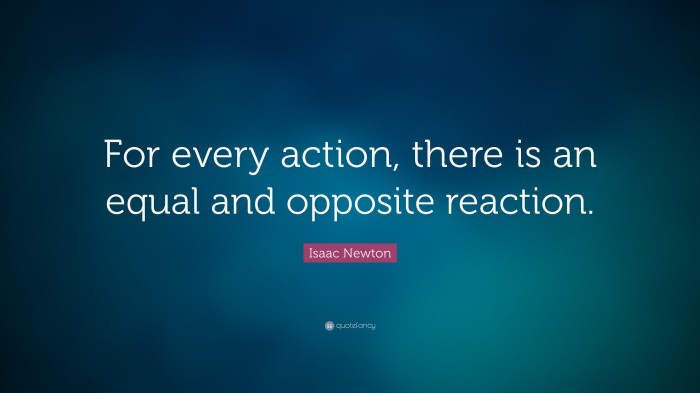
Newton’s Third Law of Motion, often referred to as the Law of Action and Reaction, is a fundamental principle in physics that describes the interactions between objects. It states that for every action, there is an equal and opposite reaction. This means that when one object exerts a force on another object, the second object exerts an equal and opposite force back on the first object.
Understanding Action and Reaction
The concepts of “action” and “reaction” in Newton’s Third Law refer to forces. “Action” refers to the force that one object exerts on another object. “Reaction” refers to the equal and opposite force that the second object exerts back on the first object. These forces always occur in pairs and act on different objects.
Examples of Newton’s Third Law
The concept of action and reaction can be illustrated with several everyday examples:
* Walking: When you walk, you push your foot backward against the ground (action). The ground, in turn, pushes forward on your foot with an equal and opposite force (reaction). This reaction force propels you forward.
* Swimming: When you swim, you push water backward with your arms and legs (action). The water pushes you forward with an equal and opposite force (reaction).
* Rocket Launch: A rocket engine expels hot gases downward (action). The gases exert an equal and opposite upward force on the rocket (reaction), propelling it into the air.
* Jumping: When you jump, you push down on the ground with your feet (action). The ground pushes back up on your feet with an equal and opposite force (reaction), launching you into the air.
Key Points about Newton’s Third Law
* Equal and Opposite: The action and reaction forces are always equal in magnitude and opposite in direction.
* Simultaneous: The action and reaction forces occur simultaneously.
* Different Objects: The action and reaction forces act on different objects.
“For every action, there is an equal and opposite reaction.”
Understanding the Law
Newton’s Third Law is not just a theoretical concept; it’s a fundamental principle that governs interactions in the physical world. It’s the foundation for understanding how forces work, and it manifests itself in numerous everyday occurrences.
To truly grasp the implications of Newton’s Third Law, it’s essential to explore real-world examples. These examples illustrate the law’s application in various fields, from physics and engineering to everyday life.
Examples of Newton’s Third Law in Action
The most intuitive way to understand Newton’s Third Law is through real-world examples. These examples showcase how the law operates in different scenarios, providing a tangible understanding of its implications.
- Rocket Launch: A rocket’s propulsion is a classic example of Newton’s Third Law. The rocket expels hot gases downward (action), and in response, the gases exert an equal and opposite force on the rocket, propelling it upward (reaction). This principle is essential for space travel.
- Walking: When you walk, you push your foot backward against the ground (action). The ground, in turn, exerts an equal and opposite force forward on your foot, propelling you forward (reaction). This seemingly simple action is a direct consequence of Newton’s Third Law.
- Swimming: Similar to walking, swimming involves pushing water backward with your arms and legs (action). The water pushes back with an equal and opposite force, propelling you forward (reaction). This is why you can’t swim effectively in a frictionless environment, like outer space.
- Jumping: When you jump, you push down on the ground (action). The ground pushes back up on you with an equal and opposite force, launching you into the air (reaction). The force you exert determines how high you jump.
Applications in Different Fields, What is newton’s 3rd law of motion
Newton’s Third Law is not just a theoretical concept; it has profound implications in various fields, influencing how we understand and design systems.
- Physics: The law forms the basis for understanding collisions, momentum conservation, and the interactions between objects. It is essential for explaining the motion of planets, stars, and galaxies.
- Engineering: Engineers use Newton’s Third Law to design structures, vehicles, and machines. For example, understanding the forces involved in bridge construction or the design of rocket engines relies heavily on this law.
- Everyday Life: Newton’s Third Law governs many everyday activities, from opening a door to playing a game of tennis. It’s the reason why pushing a cart requires effort, why you need to exert force to move a heavy object, and why you feel a recoil when firing a gun.
Key Concepts Related to Newton’s Third Law: What Is Newton’s 3rd Law Of Motion
Newton’s Third Law, often summarized as “for every action, there is an equal and opposite reaction,” lays the foundation for understanding interactions between objects in motion. This fundamental concept, however, encompasses several crucial ideas that are vital for comprehending the world around us.
Force Pairs
Force pairs, also known as action-reaction pairs, are the core of Newton’s Third Law. They represent the equal and opposite forces that two objects exert on each other when they interact. It’s essential to understand that these forces always act on different objects, not on the same object.
For every action, there is an equal and opposite reaction.
- Consider a person pushing a wall. The person exerts a force on the wall (action), and the wall simultaneously exerts an equal and opposite force on the person (reaction).
- When a rocket launches, it expels hot gas downward (action). The gas, in turn, pushes the rocket upward (reaction), propelling it into space.
Conservation of Momentum
Newton’s Third Law is intrinsically linked to the principle of conservation of momentum. This principle states that the total momentum of a closed system remains constant. Momentum is a measure of an object’s mass in motion, calculated by multiplying its mass and velocity.
- In a collision between two objects, the total momentum before the collision equals the total momentum after the collision. This is because the forces exerted by the objects on each other are equal and opposite, resulting in a transfer of momentum from one object to the other.
- For example, in a head-on collision between two cars of equal mass, if one car is stationary, and the other car is moving at 10 m/s, after the collision, the momentum of the moving car will be transferred to the stationary car, resulting in both cars moving at 5 m/s.
Misconceptions about Newton’s Third Law
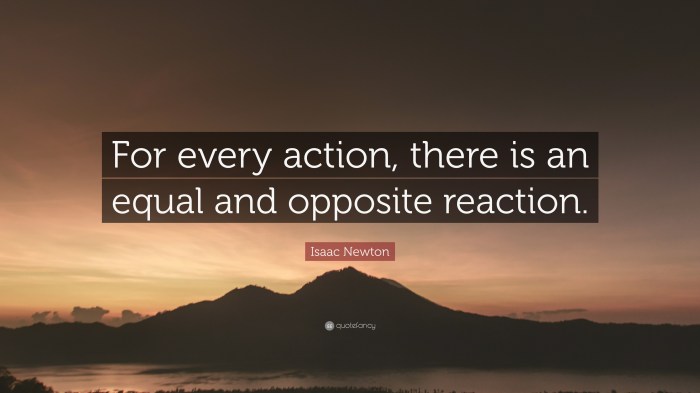
Newton’s Third Law of Motion, while seemingly straightforward, often leads to misunderstandings. These misconceptions stem from a lack of understanding of the fundamental principles and the application of the law in various scenarios. Let’s delve into some common misconceptions and clarify them with accurate explanations.
Heavier Objects Exert More Force
One common misconception is that heavier objects exert more force. This is not necessarily true. While heavier objects have a greater mass, and therefore more inertia, the force they exert is determined by the interaction with another object. The force exerted by an object is not directly proportional to its mass but rather depends on the nature of the interaction. For instance, a large truck and a small car can exert the same force on each other during a collision.
Action-Reaction Forces Cancel Each Other Out
Another misconception is that action-reaction forces cancel each other out. This is incorrect. Action-reaction forces act on different objects and therefore cannot cancel each other out. The action force acts on one object, and the reaction force acts on the other object. These forces are equal in magnitude and opposite in direction but do not act on the same object.
For example, when you push a wall, you exert a force on the wall (action). The wall, in turn, exerts an equal and opposite force on you (reaction). These forces are not canceling each other out, as they act on different objects. The wall does not move because the forces are balanced, but you may move backward because your mass is less than the wall’s.
Newton’s Third Law Explains Motion
Newton’s Third Law does not explain motion; it explains the interaction between objects. While it is crucial for understanding motion, it does not directly describe how an object moves. Newton’s First and Second Laws of Motion explain how an object moves in response to forces.
For instance, if you push a box, the box moves because of the force you apply. Newton’s Third Law tells us that the box exerts an equal and opposite force on you, but this force does not explain why the box moves. Newton’s Second Law explains that the box’s acceleration is proportional to the net force acting on it.
Further Exploration
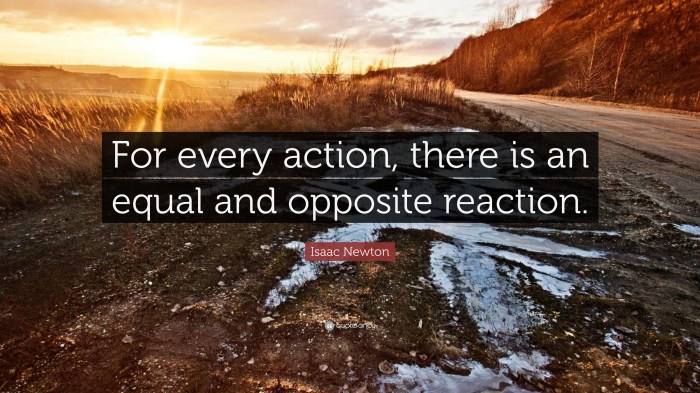
Newton’s Third Law, while seemingly simple, has profound implications in various complex scenarios. Its application extends beyond everyday interactions to encompass phenomena like collisions, rocket propulsion, and even the movement of celestial bodies.
Collisions
Newton’s Third Law plays a crucial role in understanding collisions, which are events where objects interact with significant force over a short period.
- In a collision, the forces exerted by the colliding objects on each other are equal in magnitude and opposite in direction. This means that the momentum of the system, which is the product of mass and velocity, is conserved.
- For example, consider a car colliding with a stationary wall. The car exerts a force on the wall, and the wall exerts an equal and opposite force on the car. This results in a change in the car’s momentum, causing it to slow down or even come to a stop.
- The severity of the collision depends on factors such as the masses of the objects involved, their velocities, and the duration of the impact.
Rocket Propulsion
Rocket propulsion is a prime example of Newton’s Third Law in action.
- Rockets work by expelling hot gases out of their engines, creating a force that propels the rocket in the opposite direction. The expelled gases exert a force on the rocket, and the rocket exerts an equal and opposite force on the gases.
- This principle is known as “action-reaction,” where the action is the expulsion of the gases, and the reaction is the rocket’s acceleration.
- The greater the mass of the expelled gases and the faster they are expelled, the greater the force on the rocket and the faster it accelerates.
Celestial Bodies
Newton’s Third Law also governs the interactions between celestial bodies, such as planets, stars, and galaxies.
- Every celestial body exerts a gravitational force on every other celestial body, and these forces are equal in magnitude and opposite in direction. This means that the gravitational force between the Earth and the Sun is equal to the gravitational force between the Sun and the Earth.
- This principle explains why planets orbit the Sun in elliptical paths. The gravitational force between the Sun and a planet causes the planet to accelerate towards the Sun, but the planet’s inertia keeps it moving in a curved path.
- The same principle applies to binary star systems, where two stars orbit each other due to their mutual gravitational attraction.
Summary
Newton’s Third Law of Motion is a powerful tool for understanding the world around us. It helps us understand how forces work, how objects interact, and how momentum is conserved. From the simple act of walking to the complex workings of rocket engines, this law plays a crucial role in explaining the motion of objects. By understanding Newton’s Third Law, we gain a deeper appreciation for the fundamental principles that govern the universe.
User Queries
What are some other examples of Newton’s Third Law in action?
When you jump, your feet push down on the ground (action), and the ground pushes back up on your feet (reaction), propelling you upwards. Another example is when you swim, you push water backwards (action), and the water pushes you forwards (reaction).
Does Newton’s Third Law apply to all objects, regardless of their size?
Yes, Newton’s Third Law applies to all objects, regardless of their size. It’s a fundamental law of nature.
How does Newton’s Third Law relate to the conservation of momentum?
Newton’s Third Law is directly related to the conservation of momentum. When two objects interact, the total momentum of the system remains constant. This is because the forces they exert on each other are equal and opposite, resulting in a transfer of momentum from one object to the other.
